TOYOTA URBAN CRUISER 2015 Owners Manual
Manufacturer: TOYOTA, Model Year: 2015, Model line: URBAN CRUISER, Model: TOYOTA URBAN CRUISER 2015Pages: 544, PDF Size: 16.77 MB
Page 471 of 544
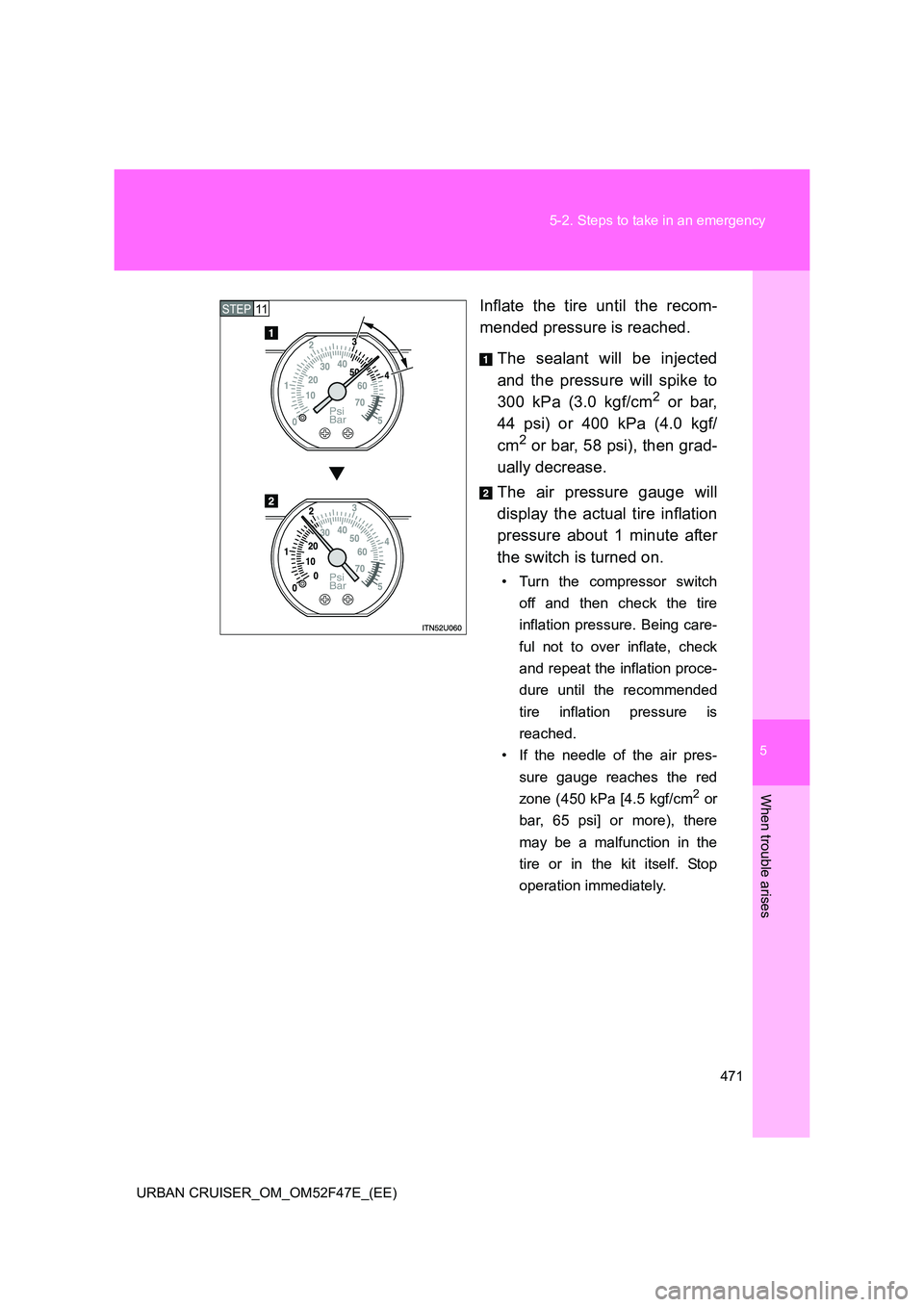
5
471
5-2. Steps to take in an emergency
When trouble arises
URBAN CRUISER_OM_OM52F47E_(EE)
Inflate the tire until the recom-
mended pressure is reached.
The sealant will be injected
and the pressure will spike to
300 kPa (3.0 kgf/cm
2 or bar,
44 psi) or 400 kPa (4.0 kgf/
cm
2 or bar, 58 psi), then grad-
ually decrease.
The air pressure gauge will
display the actual tire inflation
pressure about 1 minute after
the switch is turned on.
• Turn the compressor switch
off and then check the tire
inflation pressure. Being care-
ful not to over inflate, check
and repeat the inflation proce-
dure until the recommended
tire inflation pressure is
reached.
• If the needle of the air pres-
sure gauge reaches the red
zone (450 kPa [4.5 kgf/cm
2 or
bar, 65 psi] or more), there
may be a malfunction in the
tire or in the kit itself. Stop
operation immediately.
STEP11
Page 472 of 544
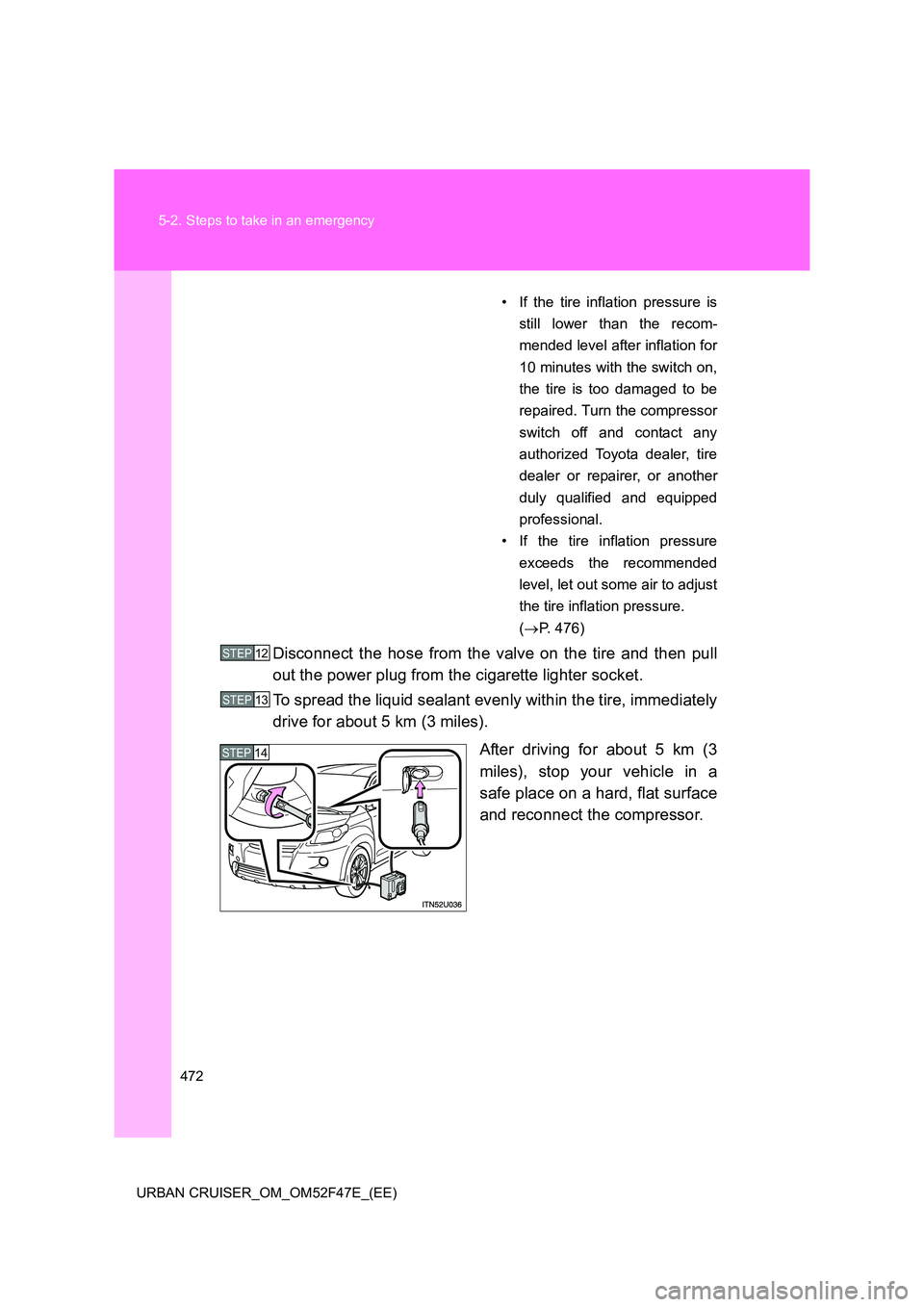
472
5-2. Steps to take in an emergency
URBAN CRUISER_OM_OM52F47E_(EE)
• If the tire inflation pressure is still lower than the recom-
mended level after inflation for
10 minutes with the switch on,
the tire is too damaged to be
repaired. Turn the compressor
switch off and contact any
authorized Toyota dealer, tire
dealer or repairer, or another
duly qualified and equipped
professional.
• If the tire inflation pressure
exceeds the recommended
level, let out some air to adjust
the tire inflation pressure.
(→ P. 476)
Disconnect the hose from the valve on the tire and then pull
out the power plug from the cigarette lighter socket.
To spread the liquid sealant evenly within the tire, immediately
drive for about 5 km (3 miles).
After driving for about 5 km (3
miles), stop your vehicle in a
safe place on a hard, flat surface
and reconnect the compressor.STEP12
STEP13
STEP14
Page 473 of 544
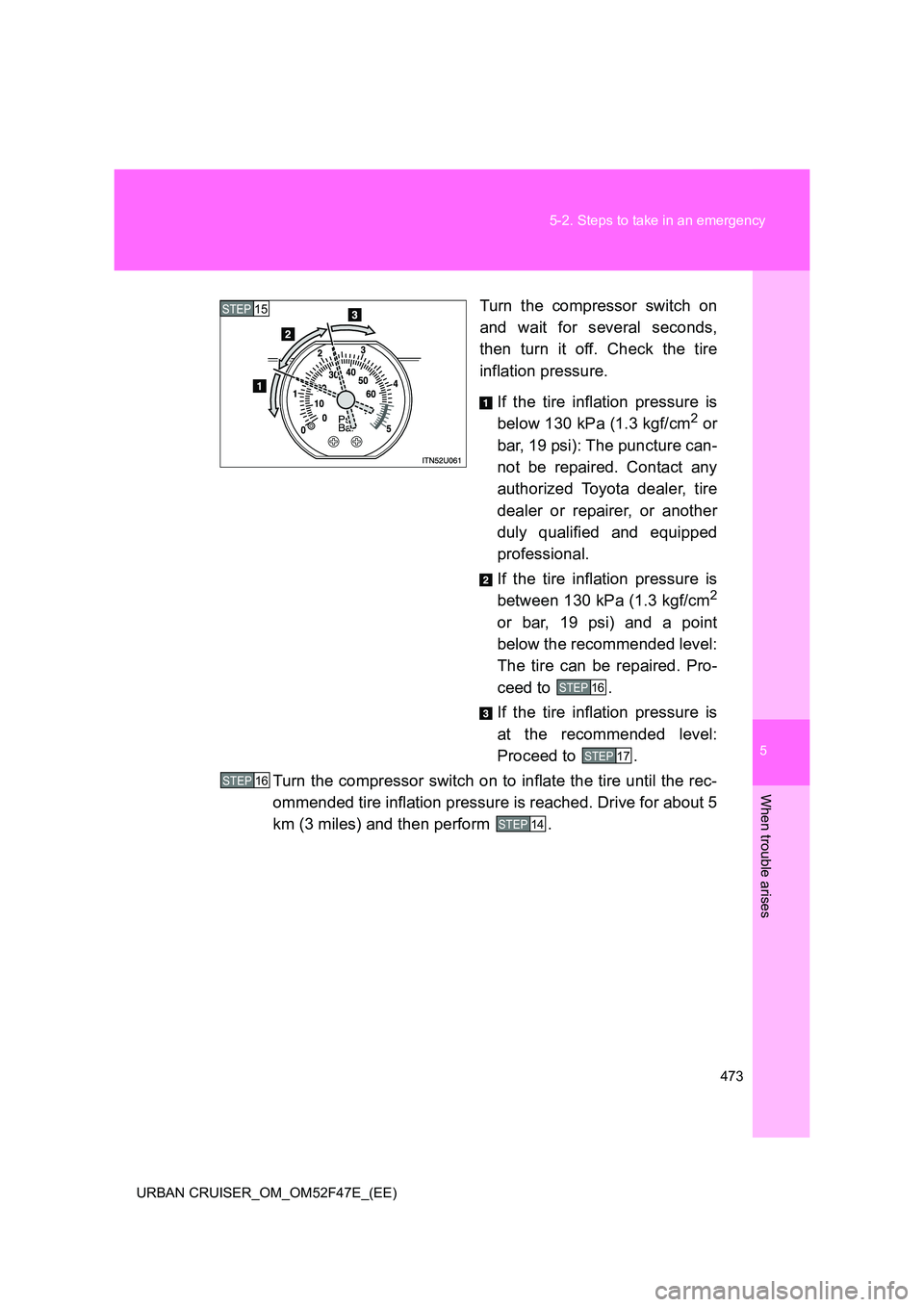
5
473
5-2. Steps to take in an emergency
When trouble arises
URBAN CRUISER_OM_OM52F47E_(EE)
Turn the compressor switch on
and wait for several seconds,
then turn it off. Check the tire
inflation pressure.
If the tire inflation pressure is
below 130 kPa (1.3 kgf/cm
2 or
bar, 19 psi): The puncture can-
not be repaired. Contact any
authorized Toyota dealer, tire
dealer or repairer, or another
duly qualified and equipped
professional.
If the tire inflation pressure is
between 130 kPa (1.3 kgf/cm
2
or bar, 19 psi) and a point
below the recommended level:
The tire can be repaired. Pro-
ceed to .
If the tire inflation pressure is
at the recommended level:
Proceed to .
Turn the compressor switch on to inflate the tire until the rec-
ommended tire inflation pressure is reached. Drive for about 5
km (3 miles) and then perform .
STEP15
STEP16
STEP17
STEP16
STEP14
Page 474 of 544
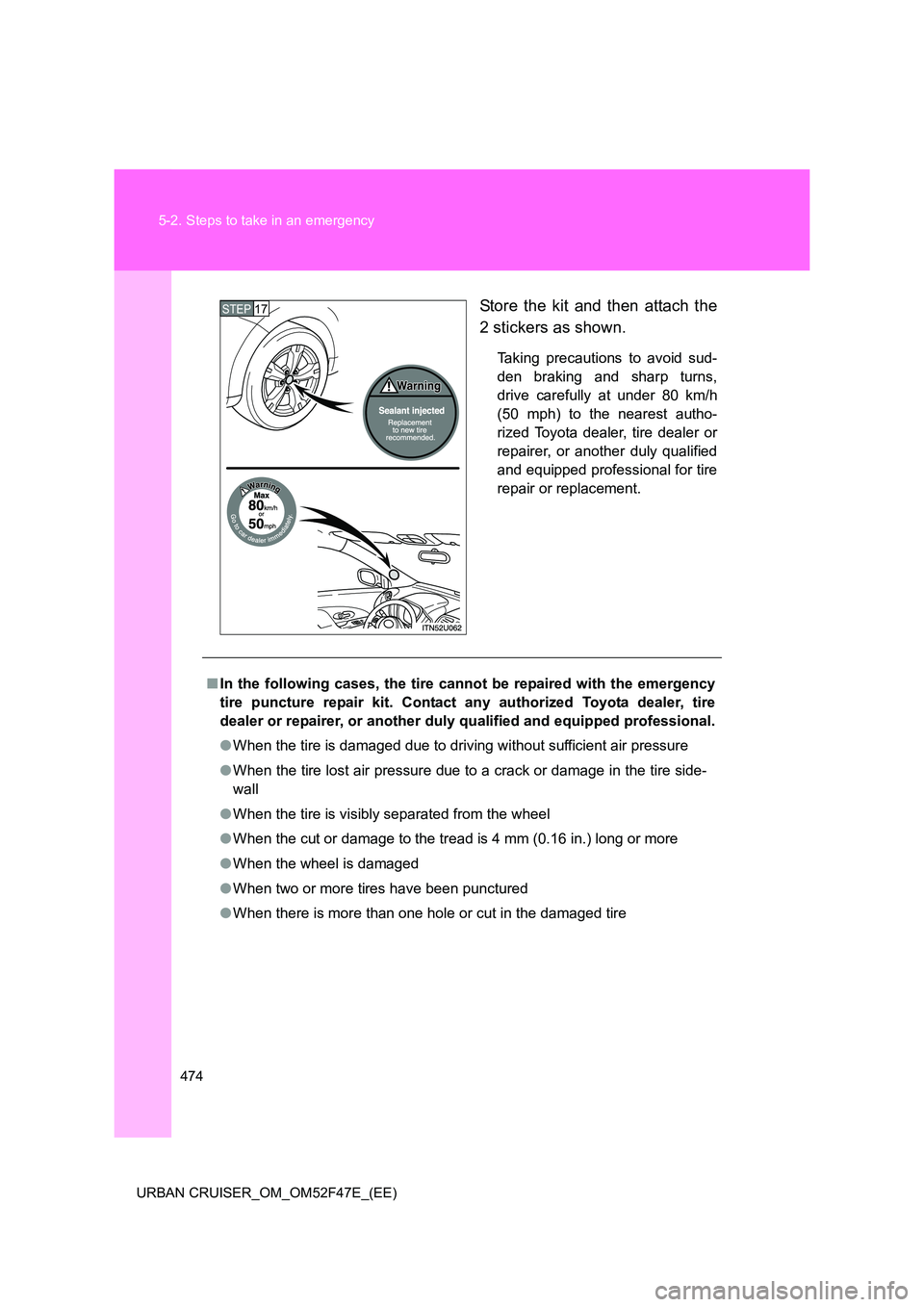
474
5-2. Steps to take in an emergency
URBAN CRUISER_OM_OM52F47E_(EE)
Store the kit and then attach the
2 stickers as shown.
Taking precautions to avoid sud-
den braking and sharp turns,
drive carefully at under 80 km/h
(50 mph) to the nearest autho-
rized Toyota dealer, tire dealer or
repairer, or another duly qualified
and equipped professional for tire
repair or replacement.
STEP17
■ In the following cases, the tire cannot be repaired with the emergency
tire puncture repair kit. Contact any authorized Toyota dealer, tire
dealer or repairer, or another duly qualified and equipped professional.
● When the tire is damaged due to driving without sufficient air pressure
● When the tire lost air pressure due to a crack or damage in the tire side-
wall
● When the tire is visibly separated from the wheel
● When the cut or damage to the tread is 4 mm (0.16 in.) long or more
● When the wheel is damaged
● When two or more tires have been punctured
● When there is more than one hole or cut in the damaged tire
Page 475 of 544
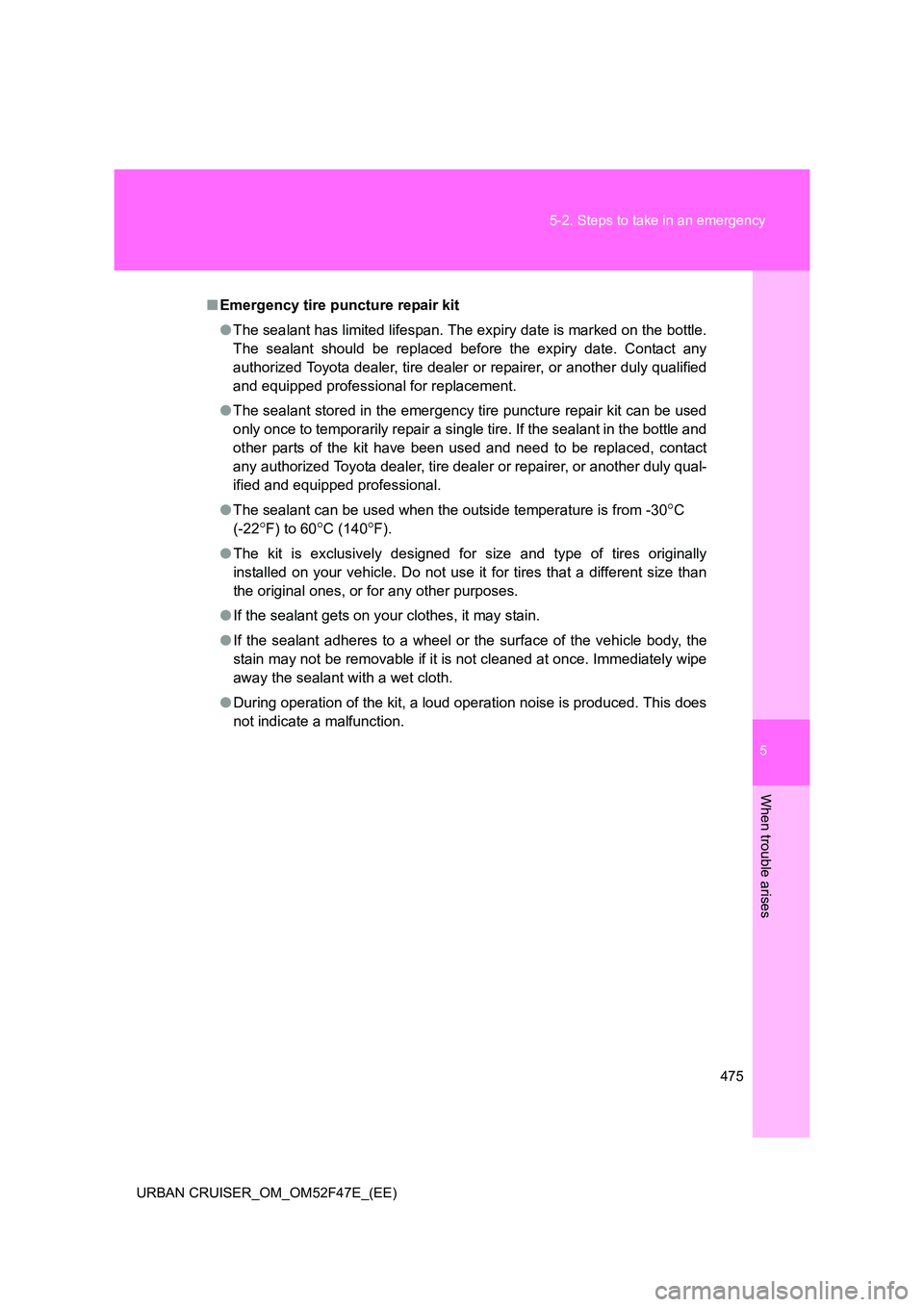
5
475
5-2. Steps to take in an emergency
When trouble arises
URBAN CRUISER_OM_OM52F47E_(EE)
■
Emergency tire puncture repair kit
●The sealant has limited lifespan. The expiry date is marked on the bottle.
The sealant should be replaced before the expiry date. Contact any
authorized Toyota dealer, tire dealer or repairer, or another duly qualified
and equipped professional for replacement.
● The sealant stored in the emergency tire puncture repair kit can be used
only once to temporarily repair a single tire. If the sealant in the bottle and
other parts of the kit have been used and need to be replaced, contact
any authorized Toyota dealer, tire deal er or repairer, or another duly qual-
ified and equipped professional.
● The sealant can be used when the outside temperature is from -30
°C
(-22
°F) to 60°C (140°F).
● The kit is exclusively designed for size and type of tires originally
installed on your vehicle. Do not use it for tires that a different size than
the original ones, or for any other purposes.
● If the sealant gets on your clothes, it may stain.
● If the sealant adheres to a wheel or the surface of the vehicle body, the
stain may not be removable if it is not cleaned at once. Immediately wipe
away the sealant with a wet cloth.
● During operation of the kit, a loud operation noise is produced. This does
not indicate a malfunction.
Page 476 of 544
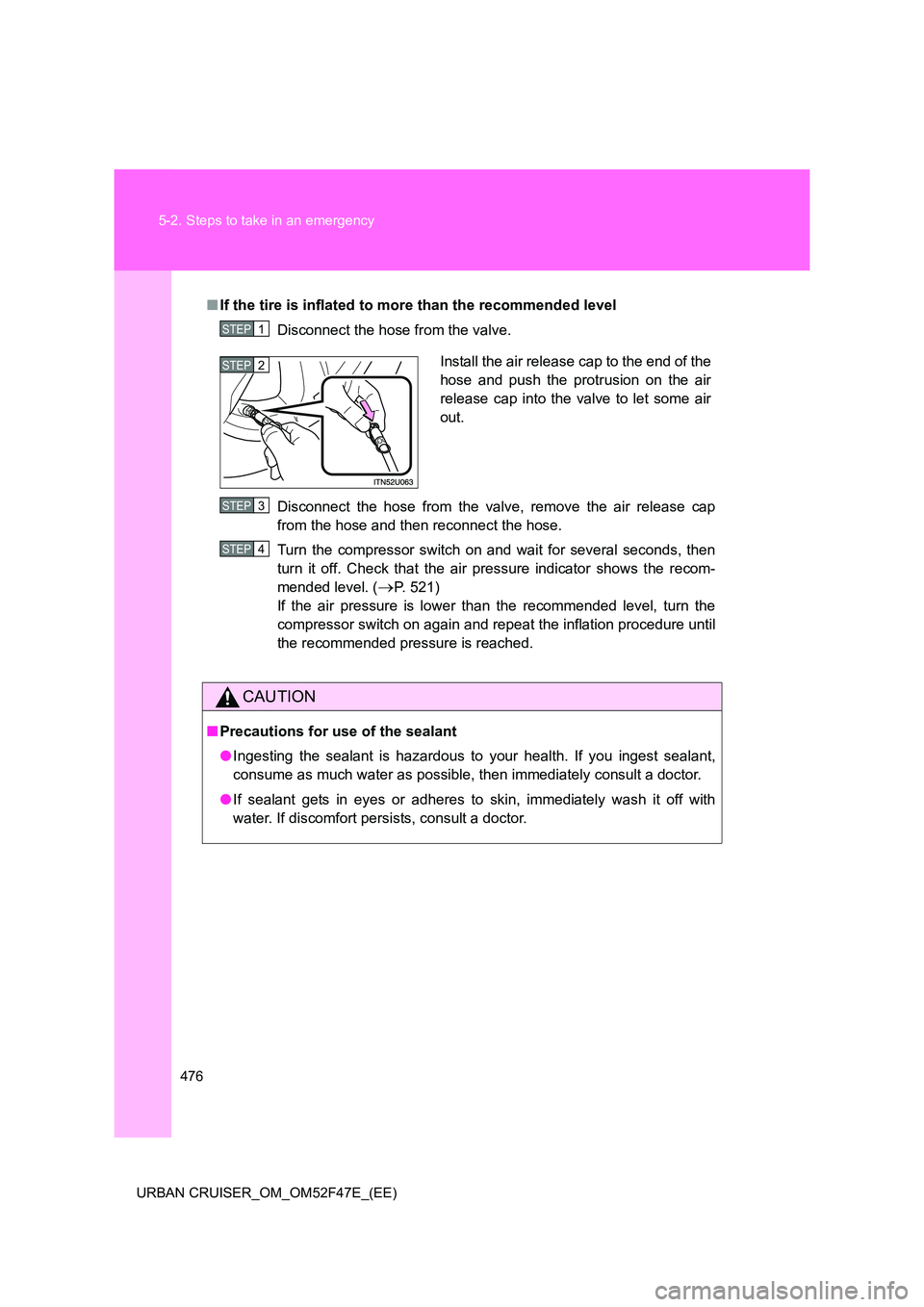
476
5-2. Steps to take in an emergency
URBAN CRUISER_OM_OM52F47E_(EE)
■ If the tire is inflated to more than the recommended level
Disconnect the hose from the valve.
Disconnect the hose from the valve, remove the air release cap
from the hose and then reconnect the hose.
Turn the compressor switch on and wait for several seconds, then
turn it off. Check that the air pressure indicator shows the recom-
mended level. (
→P. 521)
If the air pressure is lower than the recommended level, turn the
compressor switch on again and repeat the inflation procedure until
the recommended pressure is reached.
CAUTION
■ Precautions for use of the sealant
●Ingesting the sealant is hazardous to your health. If you ingest sealant,
consume as much water as possible, then immediately consult a doctor.
● If sealant gets in eyes or adheres to skin, immediately wash it off with
water. If discomfort persists, consult a doctor.
STEP1
Install the air release cap to the end of the
hose and push the protrusion on the air
release cap into the valve to let some air
out.STEP2
STEP3
STEP4
Page 477 of 544
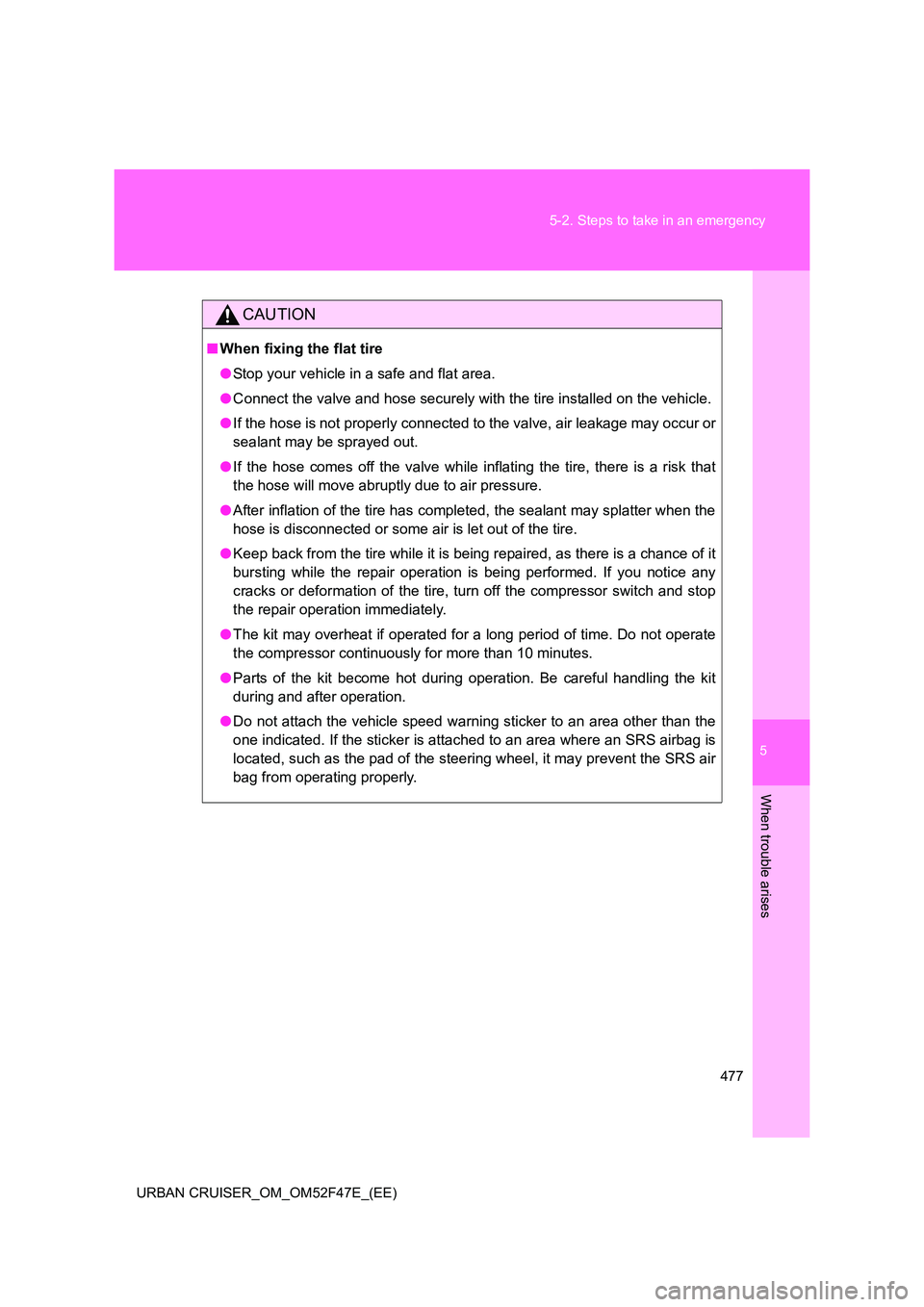
5
477
5-2. Steps to take in an emergency
When trouble arises
URBAN CRUISER_OM_OM52F47E_(EE)
CAUTION
■
When fixing the flat tire
●Stop your vehicle in a safe and flat area.
● Connect the valve and hose securely with the tire installed on the vehicle.
● If the hose is not properly connected to the valve, air leakage may occur or
sealant may be sprayed out.
● If the hose comes off the valve while inflating the tire, there is a risk that
the hose will move abruptly due to air pressure.
● After inflation of the tire has completed, the sealant may splatter when the
hose is disconnected or some air is let out of the tire.
● Keep back from the tire while it is being repaired, as there is a chance of it
bursting while the repair operation is being performed. If you notice any
cracks or deformation of the tire, turn off the compressor switch and stop
the repair operation immediately.
● The kit may overheat if operated for a long period of time. Do not operate
the compressor continuously for more than 10 minutes.
● Parts of the kit become hot during operation. Be careful handling the kit
during and after operation.
● Do not attach the vehicle speed warning sticker to an area other than the
one indicated. If the sticker is attached to an area where an SRS airbag is
located, such as the pad of the steering wheel, it may prevent the SRS air
bag from operating properly.
Page 478 of 544
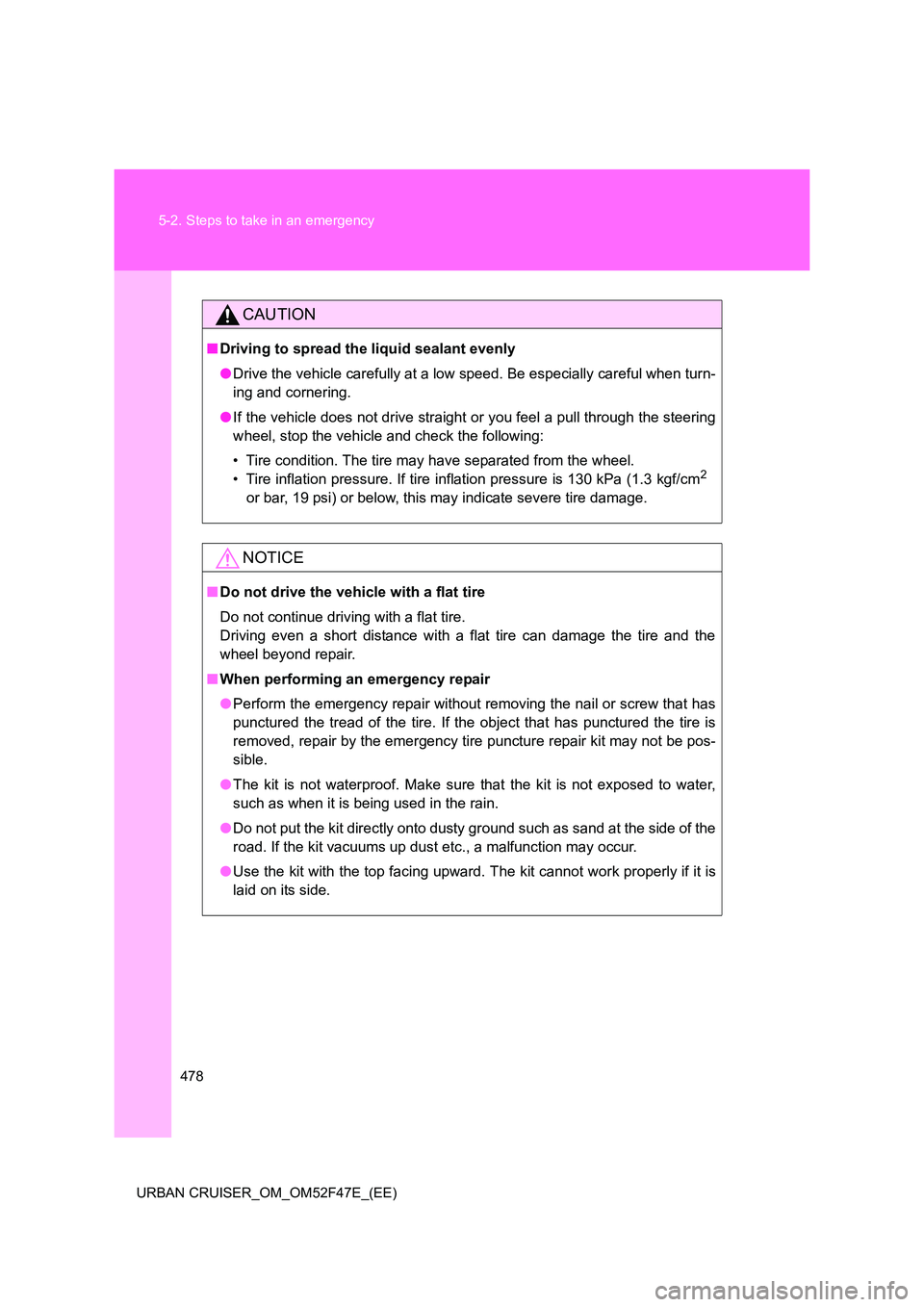
478
5-2. Steps to take in an emergency
URBAN CRUISER_OM_OM52F47E_(EE)
CAUTION
■ Driving to spread the liquid sealant evenly
●Drive the vehicle carefully at a low speed. Be especially careful when turn-
ing and cornering.
● If the vehicle does not drive straight or you feel a pull through the steering
wheel, stop the vehicle and check the following:
• Tire condition. The tire may have separated from the wheel.
• Tire inflation pressure. If tire inflation pressure is 130 kPa (1.3 kgf/cm
2
or bar, 19 psi) or below, this may indicate severe tire damage.
NOTICE
■Do not drive the vehicle with a flat tire
Do not continue driving with a flat tire.
Driving even a short distance with a flat tire can damage the tire and the
wheel beyond repair.
■ When performing an emergency repair
●Perform the emergency repair without removing the nail or screw that has
punctured the tread of the tire. If the object that has punctured the tire is
removed, repair by the emergency tire puncture repair kit may not be pos-
sible.
● The kit is not waterproof. Make sure that the kit is not exposed to water,
such as when it is being used in the rain.
● Do not put the kit directly onto dusty ground such as sand at the side of the
road. If the kit vacuums up dust etc., a malfunction may occur.
● Use the kit with the top facing upward. The kit cannot work properly if it is
laid on its side.
Page 479 of 544
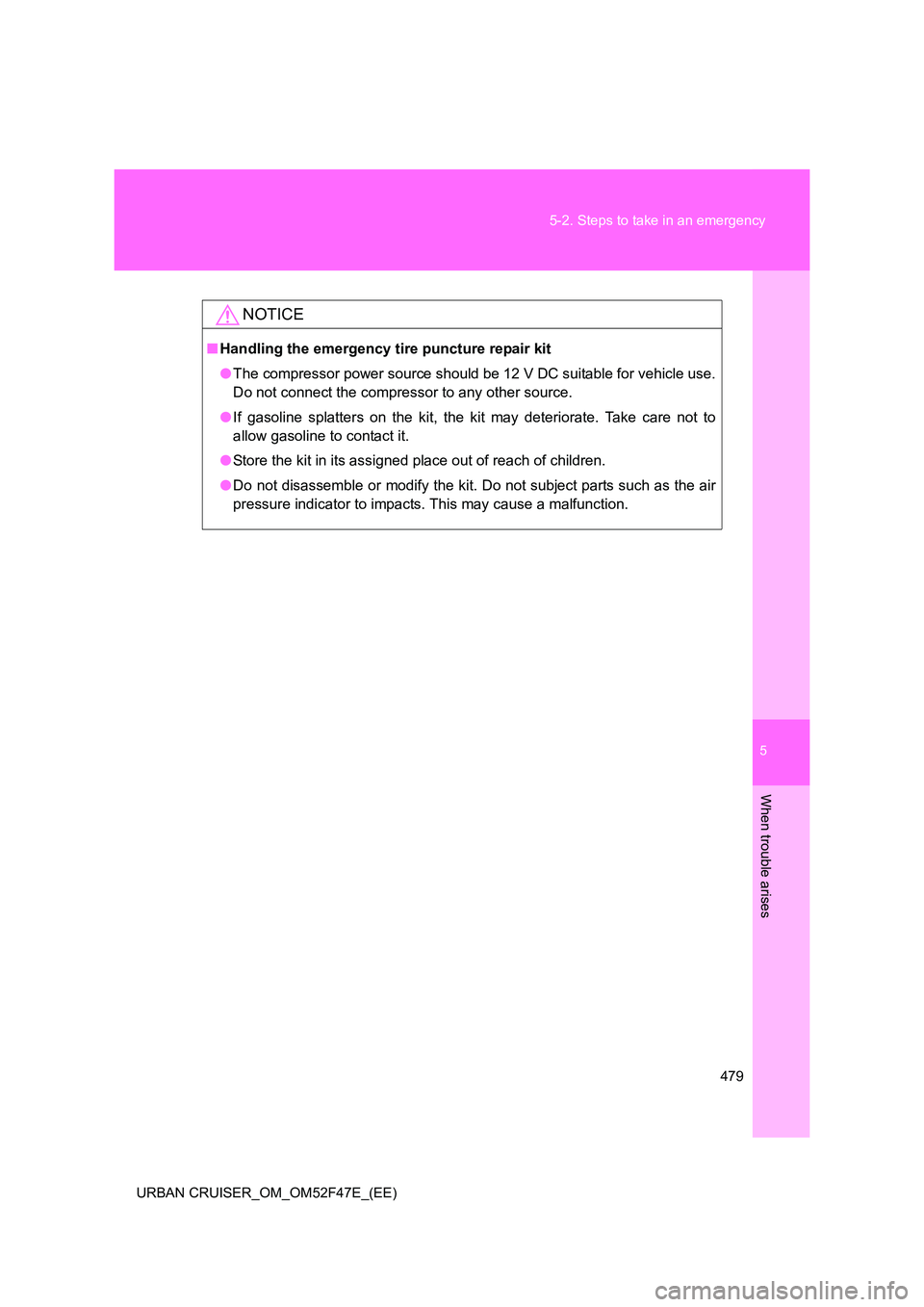
5
479
5-2. Steps to take in an emergency
When trouble arises
URBAN CRUISER_OM_OM52F47E_(EE)
NOTICE
■
Handling the emergency tire puncture repair kit
●The compressor power source should be 12 V DC suitable for vehicle use.
Do not connect the compressor to any other source.
● If gasoline splatters on the kit, the kit may deteriorate. Take care not to
allow gasoline to contact it.
● Store the kit in its assigned place out of reach of children.
● Do not disassemble or modify the kit. Do not subject parts such as the air
pressure indicator to impacts. This may cause a malfunction.
Page 480 of 544
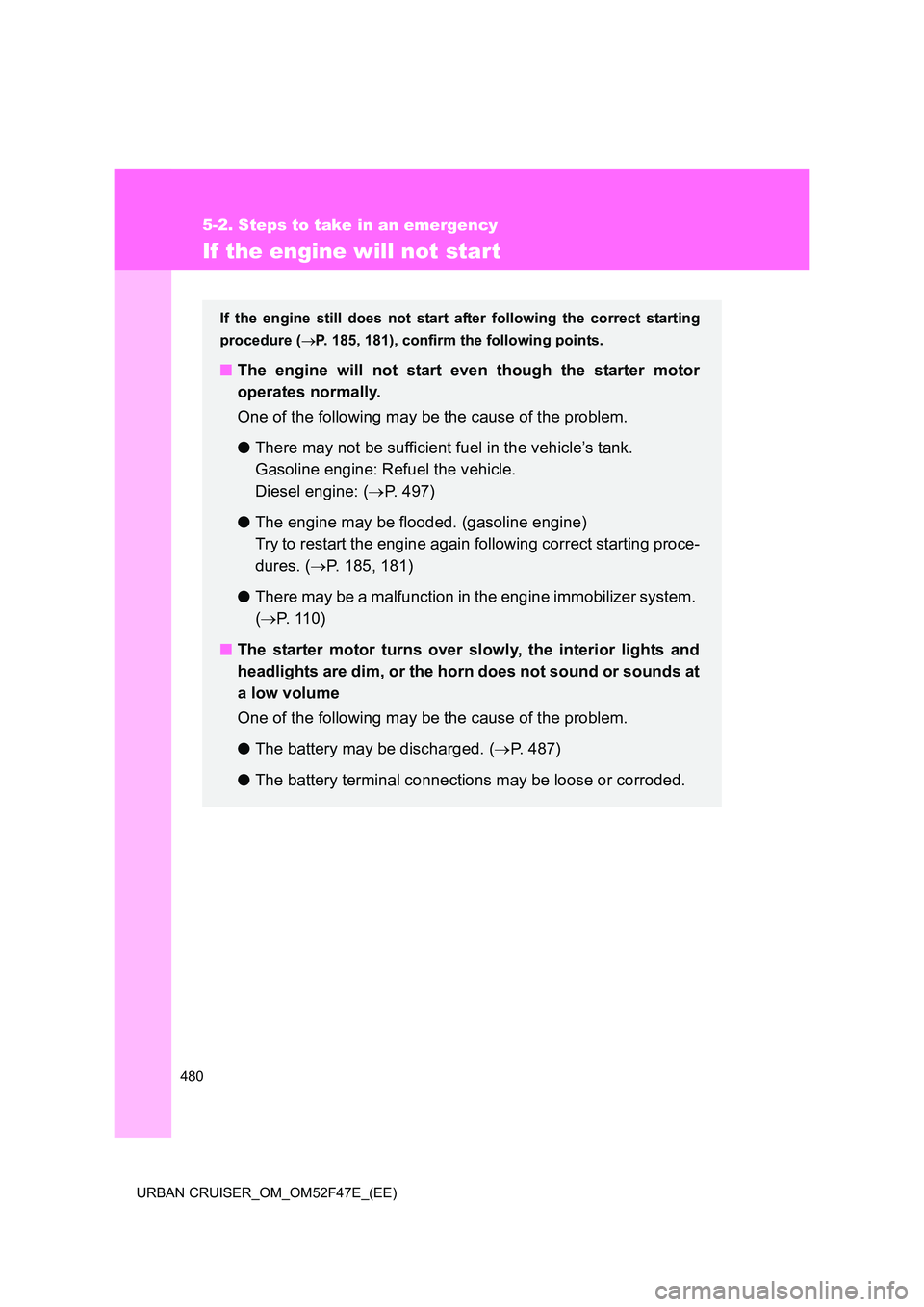
480
5-2. Steps to take in an emergency
URBAN CRUISER_OM_OM52F47E_(EE)
If the engine will not start
If the engine still does not start after following the correct starting
procedure (→P. 185, 181), confirm the following points.
■ The engine will not start even though the starter motor
operates normally.
One of the following may be the cause of the problem.
● There may not be sufficient fuel in the vehicle’s tank.
Gasoline engine: Refuel the vehicle.
Diesel engine: ( →P. 497)
● The engine may be flooded. (gasoline engine)
Try to restart the engine again following correct starting proce-
dures. ( →P. 185, 181)
● There may be a malfunction in the engine immobilizer system.
(→ P. 1 1 0 )
■ The starter motor turns over slowly, the interior lights and
headlights are dim, or the horn does not sound or sounds at
a low volume
One of the following may be the cause of the problem.
● The battery may be discharged. ( →P. 487)
● The battery terminal connections may be loose or corroded.